Bootstrap Client.md
Bootstrap
Bootstrap 可以说是一切的开始,是一个工厂类,用来初始化 Netty 客户端或者服务端 。这里以 Netty 源码 example 中 echo 中的 代码入手来分析 客户端 的 Bootstrap 类 。
源码
来到 example/src/main/java/io/netty/example/echo/EchoClient.java,代码如下:
public final class EchoClient {
static final boolean SSL = System.getProperty("ssl") != null;
static final String HOST = System.getProperty("host", "127.0.0.1");
static final int PORT = Integer.parseInt(System.getProperty("port", "8007"));
static final int SIZE = Integer.parseInt(System.getProperty("size", "256"));
public static void main(String[] args) throws Exception {
// Configure SSL.git
final SslContext sslCtx;
if (SSL) {
sslCtx = SslContextBuilder.forClient()
.trustManager(InsecureTrustManagerFactory.INSTANCE).build();
} else {
sslCtx = null;
}
// Configure the client.
EventLoopGroup group = new NioEventLoopGroup();
try {
Bootstrap b = new Bootstrap();
b.group(group)
.channel(NioSocketChannel.class)
.option(ChannelOption.TCP_NODELAY, true)
.handler(new ChannelInitializer<SocketChannel>() {
@Override
public void initChannel(SocketChannel ch) throws Exception {
ChannelPipeline p = ch.pipeline();
if (sslCtx != null) {
p.addLast(sslCtx.newHandler(ch.alloc(), HOST, PORT));
}
//p.addLast(new LoggingHandler(LogLevel.INFO));
p.addLast(new EchoClientHandler());
}
});
// Start the client.
ChannelFuture f = b.connect(HOST, PORT).sync();
// Wait until the connection is closed.
f.channel().closeFuture().sync();
} finally {
// Shut down the event loop to terminate all threads.
group.shutdownGracefully();
}
}
}
可以看到初始化的步骤:(这里暂时不分析 SSL)
- 实例化一个 Bootstrap
- 设置 group
- 设置 channel
- 设置相关配置 optional
- 设置 handler
而在 设置 handler 时,需要传入一个 Channel 初始化器,可以在其中获取到 channelPipeline 对象并在其中加入 Handler 。
Channel
先来看看 NIOSocketChannel

NioSocketChannel 继承于 SocketChannel,可以看出每当进行一个新的 Socket 链接,就会创建一个 NioSocketChannel 对象
其中 NioSocketChannel 为使用 NIO 实现的 TCP 连接的抽象,而 UDP 协议为 NioDatagramChannel 对象 。
NioSocketChannel 实例化
在 Bootstrap 中,我们调用了 channel(NioSocketChannel.class) 来指定需要实例化的类型,
public B channel(Class<? extends C> channelClass) {
return channelFactory(new ReflectiveChannelFactory<C>(
ObjectUtil.checkNotNull(channelClass, "channelClass")
));
}
最终会来到 channelFatory 方法:
public B channelFactory(io.netty.channel.ChannelFactory<? extends C> channelFactory) {
return channelFactory((ChannelFactory<C>) channelFactory);
}
public B channelFactory(ChannelFactory<? extends C> channelFactory) {
ObjectUtil.checkNotNull(channelFactory, "channelFactory");
if (this.channelFactory != null) {
throw new IllegalStateException("channelFactory set already");
}
this.channelFactory = channelFactory;
return self();
}
self 为 返回 this,只不过进行类型强转,可以看到这里主要是设置了一个 channelFatory 对象 。
实例化最终是在 connect 中实现的,链接之前会调用 initAndRegister 方法:
final ChannelFuture initAndRegister() {
Channel channel = null;
try {
channel = channelFactory.newChannel();
init(channel);
} catch (Throwable t) {
if (channel != null) {
// channel can be null if newChannel crashed (eg SocketException("too many open files"))
channel.unsafe().closeForcibly();
// as the Channel is not registered yet we need to force the usage of the GlobalEventExecutor
return new DefaultChannelPromise(channel, GlobalEventExecutor.INSTANCE).setFailure(t);
}
// as the Channel is not registered yet we need to force the usage of the GlobalEventExecutor
return new DefaultChannelPromise(new FailedChannel(), GlobalEventExecutor.INSTANCE).setFailure(t);
}
ChannelFuture regFuture = config().group().register(channel);
if (regFuture.cause() != null) {
if (channel.isRegistered()) {
channel.close();
} else {
channel.unsafe().closeForcibly();
}
}
// If we are here and the promise is not failed, it's one of the following cases:
// 1) If we attempted registration from the event loop, the registration has been completed at this point.
// i.e. It's safe to attempt bind() or connect() now because the channel has been registered.
// 2) If we attempted registration from the other thread, the registration request has been successfully
// added to the event loop's task queue for later execution.
// i.e. It's safe to attempt bind() or connect() now:
// because bind() or connect() will be executed *after* the scheduled registration task is executed
// because register(), bind(), and connect() are all bound to the same thread.
return regFuture;
}
核心在两行:
hannel = channelFactory.newChannel();
init(channel);
从上面源码中可以看出,这里 channelFactory 的最终实现是 ReflectiveChannelFactory,来到相关方法:
public ReflectiveChannelFactory(Class<? extends T> clazz) {
ObjectUtil.checkNotNull(clazz, "clazz");
try {
this.constructor = clazz.getConstructor();
} catch (NoSuchMethodException e) {
throw new IllegalArgumentException("Class " + StringUtil.simpleClassName(clazz) +
" does not have a public non-arg constructor", e);
}
}
@Override
public T newChannel() {
try {
return constructor.newInstance();
} catch (Throwable t) {
throw new ChannelException("Unable to create Channel from class " + constructor.getDeclaringClass(), t);
}
}
可以看到使用反射调用了 Channel 对象无参构造方法,因此 NioSocketChannel 实例化 在这里是使用 无参构造方法,来到该构造方法:
public NioSocketChannel() {
this(DEFAULT_SELECTOR_PROVIDER);
}
/**
* Create a new instance using the given {@link SelectorProvider}.
*/
public NioSocketChannel(SelectorProvider provider) {
this(newSocket(provider));
}
/**
* Create a new instance using the given {@link SocketChannel}.
*/
public NioSocketChannel(SocketChannel socket) {
this(null, socket);
}
/**
* Create a new instance
*
* @param parent the {@link Channel} which created this instance or {@code null} if it was created by the user
* @param socket the {@link SocketChannel} which will be used
*/
public NioSocketChannel(Channel parent, SocketChannel socket) {
super(parent, socket);
config = new NioSocketChannelConfig(this, socket.socket());
}
一层一层套娃,来到 super(parent, socket);,调用了父类的构造方法,这里 parent 为 null,而 socket 为 SocketChannel 对象,这里调用了 newSocket 方法获取:
private static SocketChannel newSocket(SelectorProvider provider) {
try {
/**
* Use the {@link SelectorProvider} to open {@link SocketChannel} and so remove condition in
* {@link SelectorProvider#provider()} which is called by each SocketChannel.open() otherwise.
*
* See <a href="https://github.com/netty/netty/issues/2308">#2308</a>.
*/
return provider.openSocketChannel();
} catch (IOException e) {
throw new ChannelException("Failed to open a socket.", e);
}
}
这里 provider 为 DEFAULT_SELECTOR_PROVIDER 对象,
private static final SelectorProvider DEFAULT_SELECTOR_PROVIDER = SelectorProvider.provider();
为常规 NIO 的获取方法,没有特别的 。
回到 super(parent, socket); 来到 AbstractNioByteChannel 的构造方法:
protected AbstractNioByteChannel(Channel parent, SelectableChannel ch) {
super(parent, ch, SelectionKey.OP_READ);
}
还是来到父类 AbstractNioChannel 构造方法:
protected AbstractNioChannel(Channel parent, SelectableChannel ch, int readInterestOp) {
super(parent);
this.ch = ch;
this.readInterestOp = readInterestOp;
try {
ch.configureBlocking(false);
} catch (IOException e) {
try {
ch.close();
} catch (IOException e2) {
logger.warn(
"Failed to close a partially initialized socket.", e2);
}
throw new ChannelException("Failed to enter non-blocking mode.", e);
}
}
可以看到 这里调用了 ch.configureBlocking(false); 将 NIO 的 channel 设置为非阻塞模式
当然这里首先还是调用了父类的构造方法,来到 AbstractChannel 的构造方法:
protected AbstractChannel(Channel parent) {
this.parent = parent;
id = newId();
unsafe = newUnsafe();
pipeline = newChannelPipeline();
}
将 parent 赋值给对应变量,然后调用 newUnsafe 方法与 newChannelPipeline 方法获取对象 。
当然对于刚刚启动的效果而言,这里的 parent 为 null 。
每个 Channel 都需要绑定 ChannelPipeline,就是在这绑定的 。
ChannelPipeline 将在之后进行分析 。
Unsafe
unsafe 为不安全的代码,一般而言是涉及底层的代码,比如 java 中支持 cas 操作的 sum.misc.Unsafe,而在 netty 中也实现了类似的操作 。
回到刚刚的代码,Channel 中,调用 newUnsafe 方法获取了一个 unsafe 对象,该方法是一个抽象方法,而对于刚刚执行的过程,其实现在 AbstractNioByteChannel 中:
@Override
protected AbstractNioUnsafe newUnsafe() {
return new NioByteUnsafe();
}
可以看到返回了一个 NioByteUnsafe 对象,来到该对象:
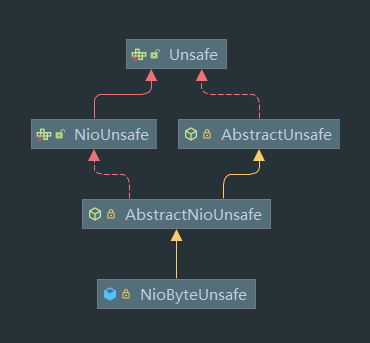
首先 Unsafe 为 netty 中封装了对底层 socket 的操作,从 Unsafe 接口的方法中也可以看出来:
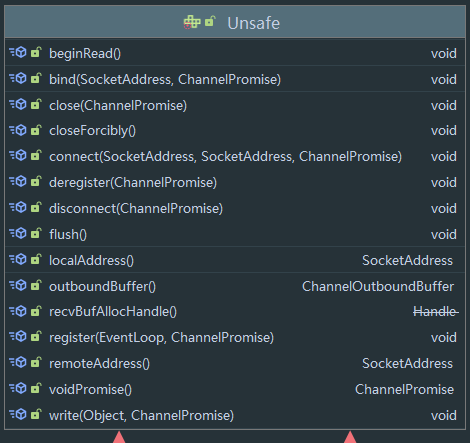
ChannelPipeline 初始化
每个 Channel 都需要绑定一个 ChannelPipeline,ChannelPipeline 实际上维护了两个责任链,入站消息责任链和出站消息责任链(实际上在同个链表中),回到刚刚的代码,我们在 AbstractChannel 中看到了 ChannelPipeline 的初始化,来到该方法:
protected DefaultChannelPipeline newChannelPipeline() {
return new DefaultChannelPipeline(this);
}
可以看到最终实例化了一个 DefaultChannelPipeline 。
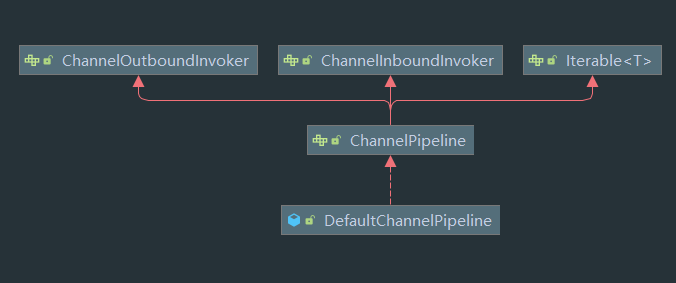
来到刚刚调用的构造方法:
protected DefaultChannelPipeline(Channel channel) {
this.channel = ObjectUtil.checkNotNull(channel, "channel");
succeededFuture = new SucceededChannelFuture(channel, null);
voidPromise = new VoidChannelPromise(channel, true);
tail = new TailContext(this);
head = new HeadContext(this);
head.next = tail;
tail.prev = head;
}
首先将我们传入的 NioSocketChannel 保存到 channel 变量中,此外,DefaultChannelPipeline 还维护了一个双向链表,分别用 tail 与 head 表示头尾节点 。

这里头节点实现了 出战消息处理器与入站消息处理器的的接口,同时要继承于 AbstractChannelHandlerContext 。
而尾节点类似,不过只实现了 入站消息处理器的接口:
final class TailContext extends AbstractChannelHandlerContext implements ChannelInboundHandler {
TailContext(DefaultChannelPipeline pipeline) {
super(pipeline, null, TAIL_NAME, TailContext.class);
setAddComplete();
}
}
NioEventLoopGroup
回到最开始,我们在 Bootstrap 中实例化了 LoopGroup:
EventLoopGroup group = new NioEventLoopGroup();
try {
Bootstrap b = new Bootstrap();
b.group(group)
// ……
我们直接调用 NioEventLoopGroup 的无参构造方法实例化该对象,这里先来看看该 NioEventLoopGroup
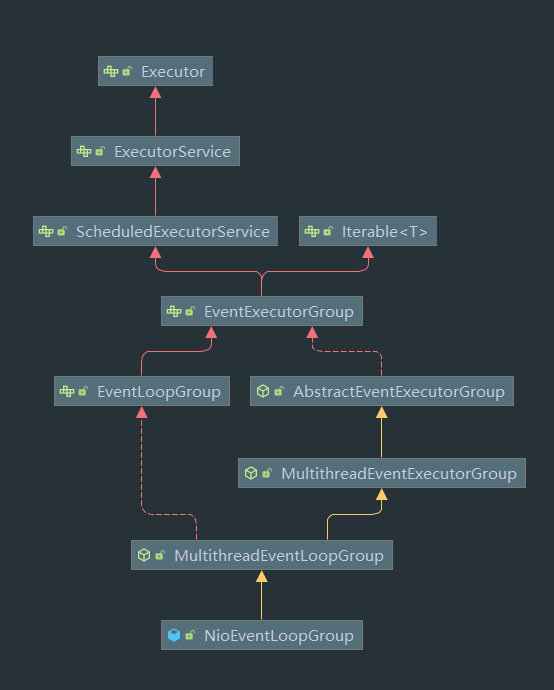
来到该构造方法:
public NioEventLoopGroup() {
this(0);
}
public NioEventLoopGroup(int nThreads) {
this(nThreads, (Executor) null);
}
public NioEventLoopGroup(int nThreads, Executor executor) {
this(nThreads, executor, SelectorProvider.provider());
}
public NioEventLoopGroup(
int nThreads, Executor executor, final SelectorProvider selectorProvider) {
this(nThreads, executor, selectorProvider, DefaultSelectStrategyFactory.INSTANCE);
}
public NioEventLoopGroup(
int nThreads,
Executor executor,
final SelectorProvider selectorProvider,
final SelectStrategyFactory selectStrategyFactory) {
super(nThreads, executor, selectorProvider, selectStrategyFactory, RejectedExecutionHandlers.reject());
}
最终会来到 super(nThreads, executor, selectorProvider, selectStrategyFactory, RejectedExecutionHandlers.reject());
该方法为 MultithreadEventLoopGroup 的构造方法:
protected MultithreadEventLoopGroup(int nThreads, Executor executor, Object... args) {
super(nThreads == 0 ? DEFAULT_EVENT_LOOP_THREADS : nThreads, executor, args);
}
注意到这里的 nThreads == 0 ? DEFAULT_EVENT_LOOP_THREADS : nThreads,也就是当我们线程数指定为 0 的时候最终会设置为默认线程数,这里的默认线程数变量会在类加载的时候初始化:
private static final int DEFAULT_EVENT_LOOP_THREADS;
static {
DEFAULT_EVENT_LOOP_THREADS = Math.max(1, SystemPropertyUtil.getInt(
"io.netty.eventLoopThreads", NettyRuntime.availableProcessors() * 2));
if (logger.isDebugEnabled()) {
logger.debug("-Dio.netty.eventLoopThreads: {}", DEFAULT_EVENT_LOOP_THREADS);
}
}
可以看到会从两个地方取值,一是配置文件中 io.netty.eventLoopThreads 的值,二是 CPU 核心数 *2,取这两者与1 三者的最大值 。
接着来到父类的构造方法,最终会来到 MultithreadEventExecutorGroup 的构造方法:
protected MultithreadEventExecutorGroup(int nThreads, Executor executor,
EventExecutorChooserFactory chooserFactory, Object... args) {
checkPositive(nThreads, "nThreads");
if (executor == null) {
executor = new ThreadPerTaskExecutor(newDefaultThreadFactory());
}
children = new EventExecutor[nThreads];
for (int i = 0; i < nThreads; i ++) {
boolean success = false;
try {
children[i] = newChild(executor, args);
success = true;
} catch (Exception e) {
// TODO: Think about if this is a good exception type
throw new IllegalStateException("failed to create a child event loop", e);
} finally {
if (!success) {
for (int j = 0; j < i; j ++) {
children[j].shutdownGracefully();
}
for (int j = 0; j < i; j ++) {
EventExecutor e = children[j];
try {
while (!e.isTerminated()) {
e.awaitTermination(Integer.MAX_VALUE, TimeUnit.SECONDS);
}
} catch (InterruptedException interrupted) {
// Let the caller handle the interruption.
Thread.currentThread().interrupt();
break;
}
}
}
}
}
chooser = chooserFactory.newChooser(children);
final FutureListener<Object> terminationListener = new FutureListener<Object>() {
@Override
public void operationComplete(Future<Object> future) throws Exception {
if (terminatedChildren.incrementAndGet() == children.length) {
terminationFuture.setSuccess(null);
}
}
};
for (EventExecutor e: children) {
e.terminationFuture().addListener(terminationListener);
}
Set<EventExecutor> childrenSet = new LinkedHashSet<EventExecutor>(children.length);
Collections.addAll(childrenSet, children);
readonlyChildren = Collections.unmodifiableSet(childrenSet);
}
其实核心就几个步骤,首先是根据线程数量初始化 children 数组:
children = new EventExecutor[nThreads];
然后在 for 循环中对这些 EventExecutor 调用 newChild 方法初始化 。
这里一个 EventExecutor 是一个线程池,派生于 EventExecutorGroup 而 EventExecutorGroup 又派生于 ScheduledExecutorService
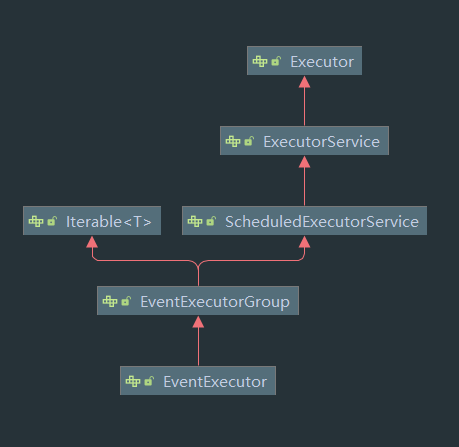
回到刚刚 MultithreadEventExecutorGroup 中,可以看到之后还有设置 chooser 的代码:
chooser = chooserFactory.newChooser(children);
DefaultEventExecutorChooserFactory 中的 newChooser 方法
@Override
public EventExecutorChooser newChooser(EventExecutor[] executors) {
if (isPowerOfTwo(executors.length)) {
return new PowerOfTwoEventExecutorChooser(executors);
} else {
return new GenericEventExecutorChooser(executors);
}
}
这里 Chooser 的功能都是一样的,当有需要的时候在 EventExecutor 数组中选择一个 EventExecutor 。
实际上 Netty 的 EventLoopGroup 实现机制就在这 MultithreadEventExecutorGroup 上,可以来看看 newChild 方法 这里是一个抽象方法,具体实现在 NioEventLoopGroup 中:
@Override
protected EventLoop newChild(Executor executor, Object... args) throws Exception {
SelectorProvider selectorProvider = (SelectorProvider) args[0];
SelectStrategyFactory selectStrategyFactory = (SelectStrategyFactory) args[1];
RejectedExecutionHandler rejectedExecutionHandler = (RejectedExecutionHandler) args[2];
EventLoopTaskQueueFactory taskQueueFactory = null;
EventLoopTaskQueueFactory tailTaskQueueFactory = null;
int argsLength = args.length;
if (argsLength > 3) {
taskQueueFactory = (EventLoopTaskQueueFactory) args[3];
}
if (argsLength > 4) {
tailTaskQueueFactory = (EventLoopTaskQueueFactory) args[4];
}
return new NioEventLoop(this, executor, selectorProvider,
selectStrategyFactory.newSelectStrategy(),
rejectedExecutionHandler, taskQueueFactory, tailTaskQueueFactory);
}
这里创建了一个新的 NioEventLoop 对象 。这是 Netty 较顶层的抽象,在底层,其实就是一个 EventExecutor 。在本例中,具体到这里会是一个线程池 。
来到 NioEventLoop :
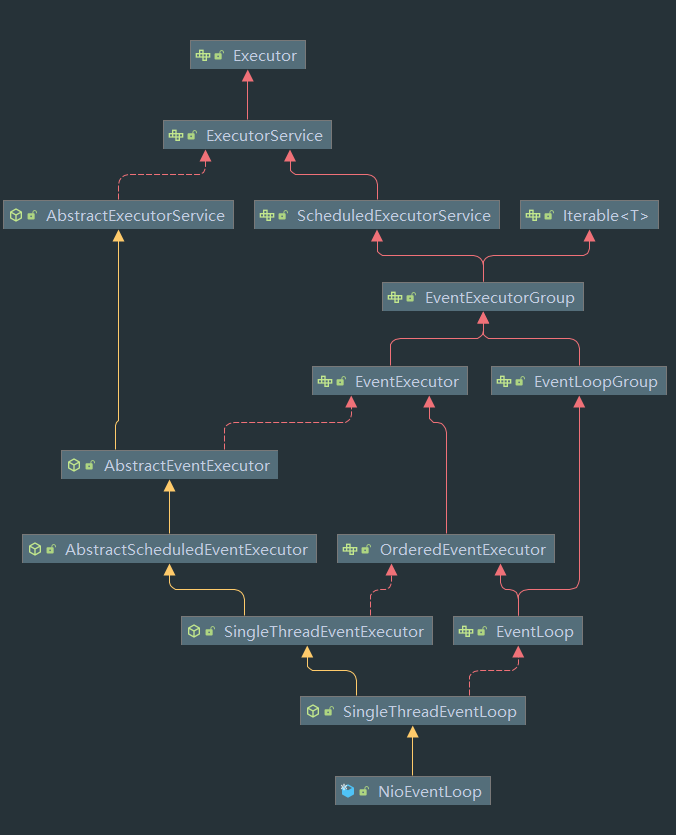
主要看到 NioEventLoop 实际上派生于 SingleThreadEventLoop 对象,也就是单线程的线程池,来到其构造方法:
NioEventLoop(NioEventLoopGroup parent, Executor executor, SelectorProvider selectorProvider,
SelectStrategy strategy, RejectedExecutionHandler rejectedExecutionHandler,
EventLoopTaskQueueFactory taskQueueFactory, EventLoopTaskQueueFactory tailTaskQueueFactory) {
super(parent, executor, false, newTaskQueue(taskQueueFactory), newTaskQueue(tailTaskQueueFactory),
rejectedExecutionHandler);
this.provider = ObjectUtil.checkNotNull(selectorProvider, "selectorProvider");
this.selectStrategy = ObjectUtil.checkNotNull(strategy, "selectStrategy");
final SelectorTuple selectorTuple = openSelector();
this.selector = selectorTuple.selector;
this.unwrappedSelector = selectorTuple.unwrappedSelector;
}
来到 openSelector()
private SelectorTuple openSelector() {
final Selector unwrappedSelector;
try {
unwrappedSelector = provider.openSelector();
} catch (IOException e) {
throw new ChannelException("failed to open a new selector", e);
}
if (DISABLE_KEY_SET_OPTIMIZATION) {
return new SelectorTuple(unwrappedSelector);
}
Object maybeSelectorImplClass = AccessController.doPrivileged(new PrivilegedAction<Object>() {
@Override
public Object run() {
try {
return Class.forName(
"sun.nio.ch.SelectorImpl",
false,
PlatformDependent.getSystemClassLoader());
} catch (Throwable cause) {
return cause;
}
}
});
if (!(maybeSelectorImplClass instanceof Class) ||
// ensure the current selector implementation is what we can instrument.
!((Class<?>) maybeSelectorImplClass).isAssignableFrom(unwrappedSelector.getClass())) {
if (maybeSelectorImplClass instanceof Throwable) {
Throwable t = (Throwable) maybeSelectorImplClass;
logger.trace("failed to instrument a special java.util.Set into: {}", unwrappedSelector, t);
}
return new SelectorTuple(unwrappedSelector);
}
final Class<?> selectorImplClass = (Class<?>) maybeSelectorImplClass;
final SelectedSelectionKeySet selectedKeySet = new SelectedSelectionKeySet();
Object maybeException = AccessController.doPrivileged(new PrivilegedAction<Object>() {
@Override
public Object run() {
try {
Field selectedKeysField = selectorImplClass.getDeclaredField("selectedKeys");
Field publicSelectedKeysField = selectorImplClass.getDeclaredField("publicSelectedKeys");
if (PlatformDependent.javaVersion() >= 9 && PlatformDependent.hasUnsafe()) {
// Let us try to use sun.misc.Unsafe to replace the SelectionKeySet.
// This allows us to also do this in Java9+ without any extra flags.
long selectedKeysFieldOffset = PlatformDependent.objectFieldOffset(selectedKeysField);
long publicSelectedKeysFieldOffset =
PlatformDependent.objectFieldOffset(publicSelectedKeysField);
if (selectedKeysFieldOffset != -1 && publicSelectedKeysFieldOffset != -1) {
PlatformDependent.putObject(
unwrappedSelector, selectedKeysFieldOffset, selectedKeySet);
PlatformDependent.putObject(
unwrappedSelector, publicSelectedKeysFieldOffset, selectedKeySet);
return null;
}
// We could not retrieve the offset, lets try reflection as last-resort.
}
Throwable cause = ReflectionUtil.trySetAccessible(selectedKeysField, true);
if (cause != null) {
return cause;
}
cause = ReflectionUtil.trySetAccessible(publicSelectedKeysField, true);
if (cause != null) {
return cause;
}
selectedKeysField.set(unwrappedSelector, selectedKeySet);
publicSelectedKeysField.set(unwrappedSelector, selectedKeySet);
return null;
} catch (NoSuchFieldException e) {
return e;
} catch (IllegalAccessException e) {
return e;
}
}
});
if (maybeException instanceof Exception) {
selectedKeys = null;
Exception e = (Exception) maybeException;
logger.trace("failed to instrument a special java.util.Set into: {}", unwrappedSelector, e);
return new SelectorTuple(unwrappedSelector);
}
selectedKeys = selectedKeySet;
logger.trace("instrumented a special java.util.Set into: {}", unwrappedSelector);
return new SelectorTuple(unwrappedSelector,
new SelectedSelectionKeySetSelector(unwrappedSelector, selectedKeySet));
}
主要是第一句:
unwrappedSelector = provider.openSelector();
之后都是对该 Selector 的设置操作 。
可以看出这里使用单线程模型配合 Nio 的 Selector 实现链接持有消息交互等操作 。
Channel 注册
回到 initAndRegister 方法:
final ChannelFuture initAndRegister() {
Channel channel = null;
try {
channel = channelFactory.newChannel();
init(channel);
} catch (Throwable t) {
if (channel != null) {
// channel can be null if newChannel crashed (eg SocketException("too many open files"))
channel.unsafe().closeForcibly();
// as the Channel is not registered yet we need to force the usage of the GlobalEventExecutor
return new DefaultChannelPromise(channel, GlobalEventExecutor.INSTANCE).setFailure(t);
}
// as the Channel is not registered yet we need to force the usage of the GlobalEventExecutor
return new DefaultChannelPromise(new FailedChannel(), GlobalEventExecutor.INSTANCE).setFailure(t);
}
ChannelFuture regFuture = config().group().register(channel);
if (regFuture.cause() != null) {
if (channel.isRegistered()) {
channel.close();
} else {
channel.unsafe().closeForcibly();
}
}
// If we are here and the promise is not failed, it's one of the following cases:
// 1) If we attempted registration from the event loop, the registration has been completed at this point.
// i.e. It's safe to attempt bind() or connect() now because the channel has been registered.
// 2) If we attempted registration from the other thread, the registration request has been successfully
// added to the event loop's task queue for later execution.
// i.e. It's safe to attempt bind() or connect() now:
// because bind() or connect() will be executed *after* the scheduled registration task is executed
// because register(), bind(), and connect() are all bound to the same thread.
return regFuture;
}
当调用完 init 方法之后,会来到这里:
ChannelFuture regFuture = config().group().register(channel);
也就是注册 channel,会来到 MultithreadEventLoopGroup 的 register 方法:
@Override
public ChannelFuture register(Channel channel) {
return next().register(channel);
}
@Override
public EventLoop next() {
return (EventLoop) super.next();
}
这里 super.next 会来到 MultithreadEventExecutorGroup 方法:
@Override
public EventExecutor next() {
return chooser.next();
}
也就是调用 chooser 的选择方法选择一个 EventExecutor,也就是 loop 。
因此最终这里会来到 NioEventLoop 的 register 方法,该类没有重写该方法,所以实际上调用的是 SingleThreadEventLoop 的方法:
@Override
public ChannelFuture register(Channel channel) {
return register(new DefaultChannelPromise(channel, this));
}
public ChannelFuture register(final ChannelPromise promise) {
ObjectUtil.checkNotNull(promise, "promise");
promise.channel().unsafe().register(this, promise);
return promise;
}
最终会来到 unsafe 对象中的 register 方法,最终调用的是 AbstractUnsafe 的 register 方法:
@Override
public final void register(EventLoop eventLoop, final ChannelPromise promise) {
ObjectUtil.checkNotNull(eventLoop, "eventLoop");
if (isRegistered()) {
promise.setFailure(new IllegalStateException("registered to an event loop already"));
return;
}
if (!isCompatible(eventLoop)) {
promise.setFailure(
new IllegalStateException("incompatible event loop type: " + eventLoop.getClass().getName()));
return;
}
AbstractChannel.this.eventLoop = eventLoop;
if (eventLoop.inEventLoop()) {
register0(promise);
} else {
try {
eventLoop.execute(new Runnable() {
@Override
public void run() {
register0(promise);
}
});
} catch (Throwable t) {
logger.warn(
"Force-closing a channel whose registration task was not accepted by an event loop: {}",
AbstractChannel.this, t);
closeForcibly();
closeFuture.setClosed();
safeSetFailure(promise, t);
}
}
}
核心在这部分:
AbstractChannel.this.eventLoop = eventLoop;
if (eventLoop.inEventLoop()) {
register0(promise);
} else {
try {
eventLoop.execute(new Runnable() {
@Override
public void run() {
register0(promise);
这里 isEventLoop 可以检测当前线程是否为该 eventLoop 中的线程,如果是就调用 register0() 否则 则在 eventLoop 线程池中调用 register0()
private void register0(ChannelPromise promise) {
try {
// check if the channel is still open as it could be closed in the mean time when the register
// call was outside of the eventLoop
if (!promise.setUncancellable() || !ensureOpen(promise)) {
return;
}
boolean firstRegistration = neverRegistered;
doRegister();
neverRegistered = false;
registered = true;
// Ensure we call handlerAdded(...) before we actually notify the promise. This is needed as the
// user may already fire events through the pipeline in the ChannelFutureListener.
pipeline.invokeHandlerAddedIfNeeded();
safeSetSuccess(promise);
pipeline.fireChannelRegistered();
// Only fire a channelActive if the channel has never been registered. This prevents firing
// multiple channel actives if the channel is deregistered and re-registered.
if (isActive()) {
if (firstRegistration) {
pipeline.fireChannelActive();
} else if (config().isAutoRead()) {
// This channel was registered before and autoRead() is set. This means we need to begin read
// again so that we process inbound data.
//
// See https://github.com/netty/netty/issues/4805
beginRead();
}
}
} catch (Throwable t) {
// Close the channel directly to avoid FD leak.
closeForcibly();
closeFuture.setClosed();
safeSetFailure(promise, t);
}
}
最终会来到 doRegister 方法,该方法在 AbstractNioChannel 中有重写:
@Override
protected void doRegister() throws Exception {
boolean selected = false;
for (;;) {
try {
selectionKey = javaChannel().register(eventLoop().unwrappedSelector(), 0, this);
return;
} catch (CancelledKeyException e) {
if (!selected) {
// Force the Selector to select now as the "canceled" SelectionKey may still be
// cached and not removed because no Select.select(..) operation was called yet.
eventLoop().selectNow();
selected = true;
} else {
// We forced a select operation on the selector before but the SelectionKey is still cached
// for whatever reason. JDK bug ?
throw e;
}
}
}
}
主要为调用 javaChannel().register 方法,
protected SelectableChannel javaChannel() {
return ch;
}
这 javaChannel 为返回 NioSocketChannel 对象 。
然后调用其 register 方法。
至此,这个 SocketChannel 注册到与 eventLoop 关联的 selector 上了
总的来说, Channel 注册过程所做的工作就是将 Channel 与对应的 EventLoop 关联, 因此这也体现了, 在 Netty 中, 每个 Channel 都会关联一个特定的 EventLoop, 并且这个 Channel 中的所有 IO 操作都是在这个 EventLoop 中执行的; 当关联好 Channel 和 EventLoop 后, 会继续调用底层的 Java NIO SocketChannel 的 register 方法, 将底层的 Java NIO SocketChannel 注册到指定的 selector 中. 通过这两步, 就完成了 Netty Channel 的注册过程.
Handler 注册
回到最初的起点,当我们要注册 Handler 的时候,我们需要传入一个 ChannelInitializer 对象,如下:
.handler(new ChannelInitializer<SocketChannel>() {
@Override
public void initChannel(SocketChannel ch) throws Exception {
ChannelPipeline p = ch.pipeline();
if (sslCtx != null) {
p.addLast(sslCtx.newHandler(ch.alloc(), HOST, PORT));
}
//p.addLast(new LoggingHandler(LogLevel.INFO));
p.addLast(new EchoClientHandler());
}
});
来看看 handler 方法:
public B handler(ChannelHandler handler) {
this.handler = ObjectUtil.checkNotNull(handler, "handler");
return self();
}
其实就是设置变量而已,最终该变量会在 init 中调用:
@Override
void init(Channel channel) {
ChannelPipeline p = channel.pipeline();
p.addLast(config.handler());
setChannelOptions(channel, newOptionsArray(), logger);
setAttributes(channel, newAttributesArray());
}
这里将 handler 本身加到 pipeline 中,这里 config.handler 会返回 bootstrap 本身的handler 对象 。
来看看 ChannelInitializer 本身的代码:
@Sharable
public abstract class ChannelInitializer<C extends Channel> extends ChannelInboundHandlerAdapter {
private static final InternalLogger logger = InternalLoggerFactory.getInstance(ChannelInitializer.class);
// We use a Set as a ChannelInitializer is usually shared between all Channels in a Bootstrap /
// ServerBootstrap. This way we can reduce the memory usage compared to use Attributes.
private final Set<ChannelHandlerContext> initMap = Collections.newSetFromMap(
new ConcurrentHashMap<ChannelHandlerContext, Boolean>());
/**
* This method will be called once the {@link Channel} was registered. After the method returns this instance
* will be removed from the {@link ChannelPipeline} of the {@link Channel}.
*
* @param ch the {@link Channel} which was registered.
* @throws Exception is thrown if an error occurs. In that case it will be handled by
* {@link #exceptionCaught(ChannelHandlerContext, Throwable)} which will by default close
* the {@link Channel}.
*/
protected abstract void initChannel(C ch) throws Exception;
@Override
@SuppressWarnings("unchecked")
public final void channelRegistered(ChannelHandlerContext ctx) throws Exception {
// Normally this method will never be called as handlerAdded(...) should call initChannel(...) and remove
// the handler.
if (initChannel(ctx)) {
// we called initChannel(...) so we need to call now pipeline.fireChannelRegistered() to ensure we not
// miss an event.
ctx.pipeline().fireChannelRegistered();
// We are done with init the Channel, removing all the state for the Channel now.
removeState(ctx);
} else {
// Called initChannel(...) before which is the expected behavior, so just forward the event.
ctx.fireChannelRegistered();
}
}
/**
* Handle the {@link Throwable} by logging and closing the {@link Channel}. Sub-classes may override this.
*/
@Override
public void exceptionCaught(ChannelHandlerContext ctx, Throwable cause) throws Exception {
if (logger.isWarnEnabled()) {
logger.warn("Failed to initialize a channel. Closing: " + ctx.channel(), cause);
}
ctx.close();
}
/**
* {@inheritDoc} If override this method ensure you call super!
*/
@Override
public void handlerAdded(ChannelHandlerContext ctx) throws Exception {
if (ctx.channel().isRegistered()) {
// This should always be true with our current DefaultChannelPipeline implementation.
// The good thing about calling initChannel(...) in handlerAdded(...) is that there will be no ordering
// surprises if a ChannelInitializer will add another ChannelInitializer. This is as all handlers
// will be added in the expected order.
if (initChannel(ctx)) {
// We are done with init the Channel, removing the initializer now.
removeState(ctx);
}
}
}
@Override
public void handlerRemoved(ChannelHandlerContext ctx) throws Exception {
initMap.remove(ctx);
}
@SuppressWarnings("unchecked")
private boolean initChannel(ChannelHandlerContext ctx) throws Exception {
if (initMap.add(ctx)) { // Guard against re-entrance.
try {
initChannel((C) ctx.channel());
} catch (Throwable cause) {
// Explicitly call exceptionCaught(...) as we removed the handler before calling initChannel(...).
// We do so to prevent multiple calls to initChannel(...).
exceptionCaught(ctx, cause);
} finally {
ChannelPipeline pipeline = ctx.pipeline();
if (pipeline.context(this) != null) {
pipeline.remove(this);
}
}
return true;
}
return false;
}
private void removeState(final ChannelHandlerContext ctx) {
// The removal may happen in an async fashion if the EventExecutor we use does something funky.
if (ctx.isRemoved()) {
initMap.remove(ctx);
} else {
// The context is not removed yet which is most likely the case because a custom EventExecutor is used.
// Let's schedule it on the EventExecutor to give it some more time to be completed in case it is offloaded.
ctx.executor().execute(new Runnable() {
@Override
public void run() {
initMap.remove(ctx);
}
});
}
}
}
重点在 channelRegistered 方法:
@Override
@SuppressWarnings("unchecked")
public final void channelRegistered(ChannelHandlerContext ctx) throws Exception {
// Normally this method will never be called as handlerAdded(...) should call initChannel(...) and remove
// the handler.
if (initChannel(ctx)) {
// we called initChannel(...) so we need to call now pipeline.fireChannelRegistered() to ensure we not
// miss an event.
ctx.pipeline().fireChannelRegistered();
// We are done with init the Channel, removing all the state for the Channel now.
removeState(ctx);
} else {
// Called initChannel(...) before which is the expected behavior, so just forward the event.
ctx.fireChannelRegistered();
}
}
会调用 initChannel(ChannelHandlerContext) 方法间接调用我们重写的 initChannel 方法,然后将自己从 ChannelPipeline 中移除(具体将在之后分析)
总结一下,对于 Handler 的注册,我们是采用传入一个 ChannelInitializer 来实现的,而 ChannelInitializer 继承于 ChannelInboundHandlerAdapter,本身就是一个 Handler,首先作为普通 Handler 存放在 ChannelPipeline 中,而在注册后,会调用我们重写的抽象方法,我们可以在抽象方法中写入自己的 Handler,而注册后,ChannelInitializer 会将自己从 ChannelPipeline 中移除 。
连接过程
接下来来看看连接过程:
回到 connect 方法的的调用,最终会来到 doResolveAndConnect 方法:
private ChannelFuture doResolveAndConnect(final SocketAddress remoteAddress, final SocketAddress localAddress) {
final ChannelFuture regFuture = initAndRegister();
final Channel channel = regFuture.channel();
if (regFuture.isDone()) {
if (!regFuture.isSuccess()) {
return regFuture;
}
return doResolveAndConnect0(channel, remoteAddress, localAddress, channel.newPromise());
} else {
// Registration future is almost always fulfilled already, but just in case it's not.
final PendingRegistrationPromise promise = new PendingRegistrationPromise(channel);
regFuture.addListener(new ChannelFutureListener() {
@Override
public void operationComplete(ChannelFuture future) throws Exception {
// Directly obtain the cause and do a null check so we only need one volatile read in case of a
// failure.
Throwable cause = future.cause();
if (cause != null) {
// Registration on the EventLoop failed so fail the ChannelPromise directly to not cause an
// IllegalStateException once we try to access the EventLoop of the Channel.
promise.setFailure(cause);
} else {
// Registration was successful, so set the correct executor to use.
// See https://github.com/netty/netty/issues/2586
promise.registered();
doResolveAndConnect0(channel, remoteAddress, localAddress, promise);
}
}
});
return promise;
}
}
initAndRegister 方法分析完了,接下来来到 doResolveAndConnect0 方法:
private ChannelFuture doResolveAndConnect0(final Channel channel, SocketAddress remoteAddress,
final SocketAddress localAddress, final ChannelPromise promise) {
try {
final EventLoop eventLoop = channel.eventLoop();
AddressResolver<SocketAddress> resolver;
try {
resolver = this.resolver.getResolver(eventLoop);
} catch (Throwable cause) {
channel.close();
return promise.setFailure(cause);
}
if (!resolver.isSupported(remoteAddress) || resolver.isResolved(remoteAddress)) {
// Resolver has no idea about what to do with the specified remote address or it's resolved already.
doConnect(remoteAddress, localAddress, promise);
return promise;
}
final Future<SocketAddress> resolveFuture = resolver.resolve(remoteAddress);
if (resolveFuture.isDone()) {
final Throwable resolveFailureCause = resolveFuture.cause();
if (resolveFailureCause != null) {
// Failed to resolve immediately
channel.close();
promise.setFailure(resolveFailureCause);
} else {
// Succeeded to resolve immediately; cached? (or did a blocking lookup)
doConnect(resolveFuture.getNow(), localAddress, promise);
}
return promise;
}
// Wait until the name resolution is finished.
resolveFuture.addListener(new FutureListener<SocketAddress>() {
@Override
public void operationComplete(Future<SocketAddress> future) throws Exception {
if (future.cause() != null) {
channel.close();
promise.setFailure(future.cause());
} else {
doConnect(future.getNow(), localAddress, promise);
}
}
});
} catch (Throwable cause) {
promise.tryFailure(cause);
}
return promise;
}
最终会来到 doConnect 方法:
private static void doConnect(
final SocketAddress remoteAddress, final SocketAddress localAddress, final ChannelPromise connectPromise) {
// This method is invoked before channelRegistered() is triggered. Give user handlers a chance to set up
// the pipeline in its channelRegistered() implementation.
final Channel channel = connectPromise.channel();
channel.eventLoop().execute(new Runnable() {
@Override
public void run() {
if (localAddress == null) {
channel.connect(remoteAddress, connectPromise);
} else {
channel.connect(remoteAddress, localAddress, connectPromise);
}
connectPromise.addListener(ChannelFutureListener.CLOSE_ON_FAILURE);
}
});
}
在 loop 中添加任务,调用 channel.connect 方法,而这里 channel 为 NioSocketChannel,因此来到 NioSocektChannel#connect 方法,实际上该类没有重写该方法,最终调用的是 AbstractChannel 中的该方法:
@Override
public ChannelFuture connect(SocketAddress remoteAddress) {
return pipeline.connect(remoteAddress);
}
可以看到来到 pipeline 的 connect 方法,而该过程中 pipeline 对象为 DefaultChannelPipeline#connect:
@Override
public final ChannelFuture connect(SocketAddress remoteAddress) {
return tail.connect(remoteAddress);
}
这里调用链表中表尾的节点的 connect 方法,这里 tail 为 TailContext,没有重写该方法,因此实际上调用的是 AbstractChannelHandlerContext 的 connect 方法:
@Override
public ChannelFuture connect(SocketAddress remoteAddress) {
return connect(remoteAddress, newPromise());
}
@Override
public ChannelFuture connect(SocketAddress remoteAddress, ChannelPromise promise) {
return connect(remoteAddress, null, promise);
}
@Override
public ChannelFuture connect(
final SocketAddress remoteAddress, final SocketAddress localAddress, final ChannelPromise promise) {
ObjectUtil.checkNotNull(remoteAddress, "remoteAddress");
if (isNotValidPromise(promise, false)) {
// cancelled
return promise;
}
final AbstractChannelHandlerContext next = findContextOutbound(MASK_CONNECT);
EventExecutor executor = next.executor();
if (executor.inEventLoop()) {
next.invokeConnect(remoteAddress, localAddress, promise);
} else {
safeExecute(executor, new Runnable() {
@Override
public void run() {
next.invokeConnect(remoteAddress, localAddress, promise);
}
}, promise, null, false);
}
return promise;
}
首先调用 findContextOutbound(MASK_CONNECT) 方法找到一个 Handler:
private AbstractChannelHandlerContext findContextOutbound(int mask) {
AbstractChannelHandlerContext ctx = this;
EventExecutor currentExecutor = executor();
do {
ctx = ctx.prev;
} while (skipContext(ctx, currentExecutor, mask, MASK_ONLY_OUTBOUND));
return ctx;
}
可以看到,这里从该节点不断往前找有对应 mask 的 MASK_CONNECT 的 handler 。
回到头节点 HeadContext ,这里 mask 的生成规则比较复杂,是根据节点类型自动生成的,在 ChannelHandlerMask 中生成,这里给出关键代码:
static final int MASK_ONLY_OUTBOUND = MASK_BIND | MASK_CONNECT | MASK_DISCONNECT |
MASK_CLOSE | MASK_DEREGISTER | MASK_READ | MASK_WRITE | MASK_FLUSH;
private static final int MASK_ALL_OUTBOUND = MASK_EXCEPTION_CAUGHT | MASK_ONLY_OUTBOUND;
有两个标记,他们都带有 MASK_CONNECT
if (ChannelOutboundHandler.class.isAssignableFrom(handlerType)) {
mask |= MASK_ALL_OUTBOUND;
if (isSkippable(handlerType, "bind", ChannelHandlerContext.class,
SocketAddress.class, ChannelPromise.class)) {
mask &= ~MASK_BIND;
}
if (isSkippable(handlerType, "connect", ChannelHandlerContext.class, SocketAddress.class,
SocketAddress.class, ChannelPromise.class)) {
mask &= ~MASK_CONNECT;
}
if (isSkippable(handlerType, "disconnect", ChannelHandlerContext.class, ChannelPromise.class)) {
mask &= ~MASK_DISCONNECT;
}
if (isSkippable(handlerType, "close", ChannelHandlerContext.class, ChannelPromise.class)) {
mask &= ~MASK_CLOSE;
}
if (isSkippable(handlerType, "deregister", ChannelHandlerContext.class, ChannelPromise.class)) {
mask &= ~MASK_DEREGISTER;
}
if (isSkippable(handlerType, "read", ChannelHandlerContext.class)) {
mask &= ~MASK_READ;
}
if (isSkippable(handlerType, "write", ChannelHandlerContext.class,
Object.class, ChannelPromise.class)) {
mask &= ~MASK_WRITE;
}
if (isSkippable(handlerType, "flush", ChannelHandlerContext.class)) {
mask &= ~MASK_FLUSH;
}
}
这里是根据有无对应方法重写来将标记去掉,可以看到如果没有 connect 方法的话,就会将 MASK_CONNECT 标记去掉,而刚刚启动流程中,HeadContext 一定带有 connect 方法 。因此从尾节点往前找,最终会来到头节点,并调用 HeadContext#connect 方法:
@Override
public void connect(
ChannelHandlerContext ctx,
SocketAddress remoteAddress, SocketAddress localAddress,
ChannelPromise promise) {
unsafe.connect(remoteAddress, localAddress, promise);
}
这里 unsafe 是 NioByteUnsafe,实际上该类没有重写方法,所以实际上来到 AbstractNioUnsafe
@Override
public final void connect(
final SocketAddress remoteAddress, final SocketAddress localAddress, final ChannelPromise promise) {
if (!promise.setUncancellable() || !ensureOpen(promise)) {
return;
}
try {
if (connectPromise != null) {
// Already a connect in process.
throw new ConnectionPendingException();
}
boolean wasActive = isActive();
if (doConnect(remoteAddress, localAddress)) {
fulfillConnectPromise(promise, wasActive);
} else {
connectPromise = promise;
requestedRemoteAddress = remoteAddress;
// Schedule connect timeout.
int connectTimeoutMillis = config().getConnectTimeoutMillis();
if (connectTimeoutMillis > 0) {
connectTimeoutFuture = eventLoop().schedule(new Runnable() {
@Override
public void run() {
ChannelPromise connectPromise = AbstractNioChannel.this.connectPromise;
if (connectPromise != null && !connectPromise.isDone()
&& connectPromise.tryFailure(new ConnectTimeoutException(
"connection timed out: " + remoteAddress))) {
close(voidPromise());
}
}
}, connectTimeoutMillis, TimeUnit.MILLISECONDS);
}
promise.addListener(new ChannelFutureListener() {
@Override
public void operationComplete(ChannelFuture future) throws Exception {
if (future.isCancelled()) {
if (connectTimeoutFuture != null) {
connectTimeoutFuture.cancel(false);
}
connectPromise = null;
close(voidPromise());
}
}
});
}
} catch (Throwable t) {
promise.tryFailure(annotateConnectException(t, remoteAddress));
closeIfClosed();
}
}
来到 doConnect,注意 这里 AbstractNioUnsafe 是 AbstractNioChannel 的内部类,而该方法是 AbstractNioChannel 中抽象方法 。最终来到的是 NioSocketChannel#connect
protected boolean doConnect(SocketAddress remoteAddress, SocketAddress localAddress) throws Exception {
if (localAddress != null) {
doBind0(localAddress);
}
boolean success = false;
try {
boolean connected = SocketUtils.connect(javaChannel(), remoteAddress);
if (!connected) {
selectionKey().interestOps(SelectionKey.OP_CONNECT);
}
success = true;
return connected;
} finally {
if (!success) {
doClose();
}
}
}
这里 bind 和 connect 最终会调用 NIO 的绑定和连接方法,此外 doBind 还根据 java 版本进行不同的方法调用:
@Override
protected void doBind(SocketAddress localAddress) throws Exception {
doBind0(localAddress);
}
private void doBind0(SocketAddress localAddress) throws Exception {
if (PlatformDependent.javaVersion() >= 7) {
SocketUtils.bind(javaChannel(), localAddress);
} else {
SocketUtils.bind(javaChannel().socket(), localAddress);
}
}
至此,Bootstrap Client 启动流程就分析完毕 。